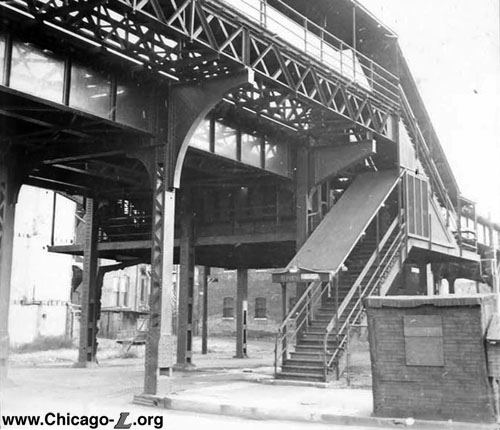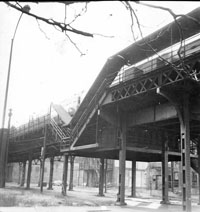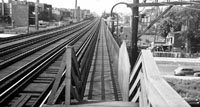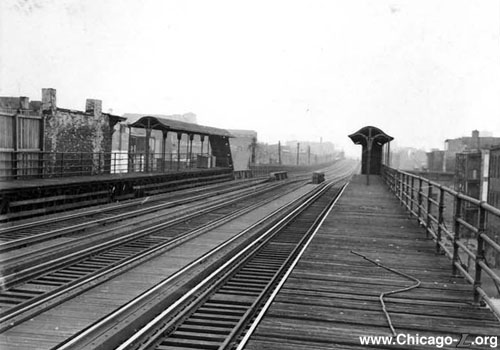.

The 33rd station entrance, mezzanine station house, and platform above are seen looking southeast on November 21, 1957. No longer an individual stop and acting as an auxiliary entrance/exit to the Tech-35th station, at this point the 33rd station was in a worn and deteriorated condition. For a larger view, click here. (Photo from the Graham Garfield Collection) |
33rd
(3300S/1E)
33rd Street and Wabash
Avenue, Douglas
Service
Notes:

|
North-South
Route: Englewood-Jackson Park
|
Quick Facts:
Address: TBD
Established: June 6, 1892
Original Line: South Side Rapid Transit
Previous Names: none
Skip-Stop Type: n/a
Rebuilt: 1907
Status: Demolished
History:
33rd Street was one of the original ten stations of Chicago's
first "L" line, the South Side Rapid Transit, built in 1892. The original station building
was a ground-level structure on the north side of the street with a brick exterior, a
large bay in the center of the front elevation, and extensive terra cotta ornamentation on the front facade. The station house interior included a ticket office (situated in the front bay), waiting area, and concession/newsstand.
|

Looking southwest along the east side of the 33rd station on November 21, 1957, the inbound platform and connecting stairs, closed to passengers at this point, are on the right, while a newer set of stairs leading to a track-level walkway to 35th station connect to the mezzanine on the left. For a larger view, click here. (Photo from the Graham Garfield Collection) |
The station had dual side platforms, which consisted of a wood deck on a steel structure. The original
canopies were humped-shaped, typical of the original South Side Rapid
Transit designs. The metal railings included ornamental scrollwork panels.
In 1907, as part of an
ordinance to allow the South Side Elevated to install a third track for
express service, all stations north of 43rd
Street, including this one, were required to replace their
ground-level station facilities with mezzanine-level stations, clearing the
space beneath the track to become open for public access. Between 18th and 39th Streets, the third track was added on the east side of the existing elevated structure, with the new track becoming the new northbound track and the old northbound track becoming a bidirectional express track. This resulted in the relocation of 33rd's northbound
platform. The replacement of the street-level station house with a mezzanine facility required the the elevated structure to the raised at the station (with grades of up to 1.44% at some stations
to compensate for the change in elevation) as the city ordinance permitting the work required that there had to be sufficient clearance under the mezzanine for vehicles to pass. This created roller
coaster-like humps in the structure -- the occasional rise and descent
can still be seen in the South Side Green Line's tracks.
The 1907-built mezzanine station house was a
fairly simple structure, constructed of steel and clad in sheet metal with simple
ornamentation. The mezzanine facility was located on the south side of 33rd Street, set a short distance back from the street, with a stairway from each side of the mezzanine down to the sidewalk for access. (The east stairway from street-level was later removed.)
|

The track-level walkway between the 33rd and 35th stations is seen looking north on August 11, 1953 from the Tech-35th platform. Only a picket fence along the walkway separates passengers from passing trains. For a larger view, click here. (Photo from the Graham Garfield Collection) |
On August 1, 1949, the CTA
instituted its North-South
Route service service revision, encompassing the Howard,
Jackson Park,
Englewood and
Ravenswood routes. Along
with creating new through-routes and services and instituting
A/B skip stop
service, 23 stations were closed along those lines. Most of the other
Near South Side stations, such as 18th,
26th, 29th, 31st, and
39th, were shuttered, but 33rd station was
spared, despite being adjacent to Tech-35th,
another station kept open. The station's location adjacent to the
Illinois Institute of
Technology may have been the reason why. However, rather than being retained as an additional stop, it became an auxiliary entrance and exit for the Tech-35th station. A walkway built from
the 33rd station along side the northbound track to 35th's
northbound side platform, connecting the two stations. The long walkway was separated from passing trains by only a wooden fence.
By late 1957, the station facility was in poor condition. The 33rd facility, while open as an exit at all times, only had a part-time agent, and was otherwise unstaffed. Hand-written notes with a series of photos dated November 21, 1957, described that the interior of the mezzanine building "is charred from previous fire and portions of walls and ceiling are missing.
Plumbing and toilet facilities have been removed. Corrugated siding has been used to seal door and window openings." The platforms, which had not been in use since 1949, were specified as being six cars long, with "many planks missing or rotted" and "electrical work not intact."
A few years later, a new center island platform was built for Tech-35th
station, completed and opened in June 1961. Tech-35th's
southbound side platform was closed, but the northbound platform was
retained for a short period to continue act was a walkway to the 33rd
auxiliary entrance/exit. However, this continued only until September
of that year. At that time, a simple auxiliary entrance/exit for
Tech-35th was built at 34th Street
with access directly to the new island platform. On September 25,
1961, the 33rd entrance and walkway were
closed. The former station facility and walkway were eventually demolished.

The 33rd station platforms are seen looking south on November 21, 1957. Still sporting their original 1892 "humpback" canopies, that platforms had been out of service for eight years at this point and were in a deteriorated condition, described as having "many planks missing or rotted" and "electrical work not intact." In the distance, the walkway to Tech-35th station is visible. For a larger view, click here. (Photo from the Graham Garfield Collection) |
.






